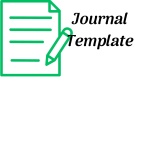Author Guidelines
Submission Preparation
Article submission template in Bahasa: https://tinyurl.com/mrwt8ctr
Article submission template in English: https://tinyurl.com/3mu4dk79
Manuscripts are typed with Times New Roman font size 11 pts for text and 10 pts for pictures and tables, with 1.5 spacing on A4 paper (210 x 297 mm). Articles are written according to the article template format on the journal website. Articles are written a maximum of 15 pages including pictures and tables. The title, author, and abstract are written in a single-column format. The introduction until references section is written in a two-column format.
- Title
The title reflects the content of the article and is written in Indonesian and English with a maximum of 16 words. The author lists the name and affiliation under the English title. Written names is a full name without degree followed by the full affiliation including institution's address and email. Correspondence authors are marked with an asterisk (*). If one author is affiliated to more than one organization, the other institutions are listed using numbers in order of affiliation.
- Abstract
Abstract written in Indonesian and English with a maximum number of 250 words. English abstract is written in italics. Abstract briefly describes the background and objectives of the research, brief methods, research results, and conclusions. Avoid using abbreviations and references in abstracts.
- Keywords
Keywords are written below the abstract in Indonesian and English. Keywords consist of 3-6 words and are written in alphabetical order.
- Introduction
The introduction section contains the basic theory, the problems that become the background of the research, the aims and objectives of the research and the contribution of the research.
- Methodology
Methods are written in paragraph. Provide complete information about the material and experimental procedures used. Methods must be described clearly to enable other scientists to repeat the procedures. If the method refers to other research, provide the reference and citation. If the method has not been published before, describe the methods as clear as possible.
- Results and Discussion
Describe the results acquired from the experiments with the appropriate analysis relevant to theories and other research. The units of measurement refer to the international guidelines. The experimental data shown in the table should not be repeated in a figure and vice versa.
- Conclusion
Conclusions are written in paragraphs contains summary of the research results and suggestions or prospects for future research.
- Acknowledgement
Information regarding acknowledgments who helped with research or in the preparation of articles. Mention the grants (the institution, the year of contract) supporting the research in this section.
- Conflict of Interest
The author must disclose the possible conflict of interest may occur during the research or preparation of the article.
- Figures and Tables
Put figures and tables in Results and Discussion section, formatted to fit the column width, and numbered in the order they are first mentioned in the text, using Arabic numeral format (1,2,3,…). Tables are arranged in an unlined left-side and right-side format. The captions/legends of the figures are placed below the figure and the caption for the table placed above the tables (max 20 words). Sources of figures and tables must be cited.
- References
Minimum references used are 10 references, with 70% of them are primary references published in last 10-year. References should be cited in author’s last name and year (Author, 2022) based on citation mode APA (American Psychological Association) 7th edition. Authors are recommended to use reference manager (EndNote, Mendeley, or Zotero) in building the bibliography to prevent typos and repetition of references.
The following is a systematic guide to writing a bibliography:
Journal
Chang C, Gong S, Liu Z, Yan Q, Jiang Z. 2021. High level expression and biochemical characterization of an alkaline serine protease from Geobacillus stearothermophilus to prepare antihypertensive whey protein hydrolysate. BMC Biotechnology. 21(1):1–13. doi:10.1186/s12896021006787
Books
Fusco, G., & Minelli, A. (2019). The Biology of Reproduction. Cambridge: Cambridge University Press. doi:10.1017/9781108758970
Book Chapter
Moore, L., & Hatcher, J. (2019). Microbiology and Virology Laboratory Practice. In Infectious Diseases, Microbiology and Virology: A Q&A Approach for Specialist Medical Trainees (pp. 24-59). Cambridge: Cambridge University Press. doi:10.1017/9781316659373.003
Proceeding
Nugroho, Y. A., Bachruddin, Z., Widodo, W., Erwanto, Y., & Hanim, C. (2022). The Ks and µmax Determination of Proteolytic Lactic Acid Bacteria Isolated from Colostrum of Dairy Cattle with Differences in Energy Source Levels. Proceedings of the 6th International Seminar of Animal Nutrition and Feed Science (ISANFS 2021), 22–25. https://doi.org/10.2991/absr.k.220401.005
Thesis and Dissertation
Arif F. 2013. Cloning and sequencing of haloacid dehalogenase gene from Bacillus
cereus local strain [Skripsi]. [Bandung]: Institut Teknologi Bandung.
Website
WHO. 2020. Pneumococcal Disease [online].https://www.who.int/ith/diseases/pneumococcal/en/. Diakses pada 12 Desember 2020.






